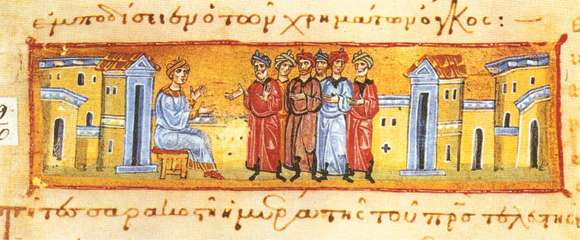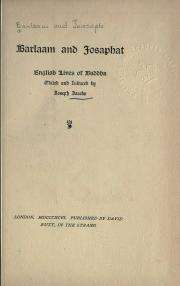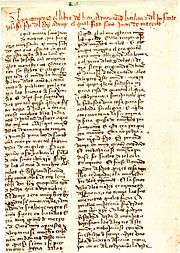Barlaam and Josaphat
Barlaam and Josaphat are legendary Christian martyrs and saints. Their life story is very likely to have been based on the life of the Gautama Buddha.[1] It tells how an Indian king persecuted the Christian Church in his realm. When astrologers predicted that his own son would some day become a Christian, the king imprisoned the young prince Josaphat, who nevertheless met the hermit Saint Barlaam and converted to Christianity. After much tribulation the young prince's father accepted the Christian faith, turned over his throne to Josaphat, and retired to the desert to become a hermit. Josaphat himself later abdicated and went into seclusion with his old teacher Barlaam.[2] The tale derives from a second to fourth century Sanskrit Mahayana Buddhist text, via a Manichaean version[3], then the Arabic Kitāb Bilawhar wa-Būd̠āsaf (Book of Bilawhar and Budhasaf), current in Baghdad in the eighth century, from where it entered into Middle Eastern Christian circles before appearing in European versions. The two were entered in the Eastern Orthodox calendar with a feast-day on 26 August,[4] and in the Roman Martyrology in the Western Church as "Barlaam and Josaphat" on the date of 27 November.[5]

Background: the Buddha
The story of Barlaam and Josaphat or Joasaph is a Christianized and later version of the story of Siddhartha Gautama, who became the Buddha.[6] In the Middle Ages the two were treated as Christian saints, being entered in the Greek Orthodox calendar on 26 August,[4] and in the Roman Martyrology in the Western Church as "Barlaam and Josaphat" on the date of 27 November.[5] In the Slavic tradition of the Eastern Orthodox Church, these two are commemorated on 19 November (corresponding to 2 December on the Gregorian calendar).[7][8]
The first Christianized adaptation was the Georgian epic Balavariani dating back to the 10th century. A Georgian monk, Euthymius of Athos, translated the story into Greek, some time before he died in an accident while visiting Constantinople in 1028.[9] There the Greek adaptation was translated into Latin in 1048 and soon became well known in Western Europe as Barlaam and Josaphat.[10] The Greek legend of "Barlaam and Ioasaph" is sometimes attributed to the 7th century John of Damascus, but Conybeare argued it was transcribed by the Georgian monk Euthymius in the 11th century.[11]
The story of Barlaam and Josaphat was popular in the Middle Ages, appearing in such works as the Golden Legend, and a scene there involving three caskets eventually appeared, via Caxton's English translation of a Latin version, in Shakespeare's "The Merchant of Venice".[12]
Two Middle High German versions were produced: one, the "Laubacher Barlaam", by Bishop Otto II of Freising and another, Barlaam und Josaphat, a romance in verse, by Rudolf von Ems. The latter was described as "perhaps the flower of religious literary creativity in the German Middle Ages" by Heinrich Heine.[13]
The story of Josaphat was re-told as an exploration of free will and the seeking of inner peace through meditation in the 17th century.
The legend
According to the legend, King Abenner or Avenier in India persecuted the Christian Church in his realm, founded by the Apostle Thomas. When astrologers predicted that his own son would some day become a Christian, Abenner had the young prince Josaphat isolated from external contact. Despite the imprisonment, Josaphat met the hermit Saint Barlaam and converted to Christianity. Josaphat kept his faith even in the face of his father's anger and persuasion. Eventually Abenner converted, turned over his throne to Josaphat, and retired to the desert to become a hermit. Josaphat himself later abdicated and went into seclusion with his old teacher Barlaam.[2]
Name
Ioasaph (Georgian Iodasaph, Arabic Yūdhasaf or Būdhasaf) is derived from the Sanskrit Bodhisattva.[5][6][14] The Sanskrit word was changed to Bodisav in Persian texts in the 6th or 7th century, then to Budhasaf or Yudasaf in an 8th-century Arabic document (possibly Arabic initial "b" ﺑ changed to "y" ﻳ by duplication of a dot in handwriting).[15] This became Iodasaph in Georgia in the 10th century, and that name was adapted as Ioasaph in Greece in the 11th century, and then was assimilated to Iosaphat/Josaphat in Latin.[16]
Feast day
Although Barlaam and Josaphat were never formally canonized, they were included in earlier editions of the Roman Martyrology (feast day 27 November)[17][18] — though not in the Roman Missal — and in the Eastern Orthodox Church liturgical calendar (26 August in Greek tradition etc.[4] / 19 November in Russian tradition).[7][8]
Texts

There are a large number of different books in various languages, all dealing with the lives of Saints Barlaam and Josaphat in India. In this hagiographic tradition, the life and teachings of Josaphat have many parallels with those of the Buddha. "But not till the mid-nineteenth century was it recognised that, in Josaphat, the Buddha had been venerated as a Christian saint for about a thousand years."[19] The authorship of the work is disputed. The origins of the story seem to be a Central Asian manuscript written in the Manichaean tradition. This book was translated into Georgian and Arabic.
Greek manuscripts
The best-known version in Europe comes from a separate, but not wholly independent, source, written in Greek, and, although anonymous, attributed to a monk named John. It was only considerably later that the tradition arose that this was John of Damascus, but most scholars no longer accept this attribution. Instead much evidence points to Euthymius of Athos, a Georgian who died in 1028.[20]
The modern edition of the Greek text, from the 160 surviving variant manuscripts (2006), with introduction (German, 2009) is published as Volume 6 of the works of John the Damascene by the monks of the Abbey of Scheyern, edited by Robert Volk. It was included in the edition due to the traditional ascription, but marked "spuria" as the translator is the Georgian monk Euthymius the Hagiorite (ca. 955–1028) at Mount Athos and not John the Damascene of the monastery of Saint Sabas in the Judaean Desert. The 2009 introduction includes an overview[21]
English manuscripts
Among the manuscripts in English, two of the most important are the British Museum MS Egerton 876 (the basis for Ikegami's book) and MS Peterhouse 257 (the basis for Hirsh's book) at the University of Cambridge. The book contains a tale similar to The Three Caskets found in the Gesta Romanorum and later in Shakespeare's The Merchant of Venice.[20]
Editions
Arabic
- E. Rehatsek – The Book of the King's Son and the Ascetic – English translation (1888) based on the Halle Arabic manuscript
- Gimaret – Le livre de Bilawhar et Budasaf – French translation of Bombay Arabic manuscript
Georgian
- David Marshall Lang: The Balavariani: A Tale from the Christian East California University Press: Los Angeles, 1966. Translation of the long version Georgian work that probably served as a basis for the Greek text. Jerusalem MS140
- David Marshall Lang: Wisdom of Balahvar – the short Georgian version Jerusalem MS36, 1960
- The Balavariani (Georgian and Arabic ბალავარიანი, بلوریانی)
Greek

- Robert Volk, Die Schriften des Johannes von Damaskos VI/1: Historia animae utilis de Barlaam et Ioasaph (spuria). Patristische Texte und Studien Bd. 61. Berlin: Walter de Gruyter, 2009. Pp. xlii, 596. ISBN 978-3-11-019462-3.
- Robert Volk, Die Schriften des Johannes von Damaskos VI/2: Historia animae utilis de Barlaam et Ioasaph (spuria). Text und zehn Appendices. Patristische Texte und Studien Bd. 60. Berlin: Walter de Gruyter, 2006. Pp. xiv, 512. ISBN 978-3-11-018134-0.
- Boissonade – older edition of the Greek
- G.R. Woodward and H. Mattingly – older English translation of the Greek Online Harvard University Press, Cambridge MA, 1914
- S. Ioannis Damasceni Historia, de vitis et rebvs gestis SS. Barlaam Eremitae, & Iosaphat Indiæ regis. Iacobo Billio Prunæo, S. Michaëlis in eremo Cœnobiarcha interprete. Coloniae, In Officina Birckmannica, sumptibus Arnoldi Mylij. Anno M. D. XCIII. – Modern Latin translation of the Greek.
- Vitæ et res gestæ SS. Barlaam eremitæ, et Iosaphat Indiæ regis. S. Io. Damasceno avctores, Iac. Billio Prunæo interprete. Antverpiæ, Sumptibus Viduæ & hæredum Ioannis Belleri. 1602. – Modern Latin translation of the Greek.
- S. Ioannis Damasceni Historia, de vitis et rebvs gestis SS. Barlaam Eremitæ, & Iosaphat Indiæ regis. Iacobo Billio Prvnæo, S. Michaëlis in eremo Cœnobiarcha, interprete. Nune denuò accuratissimè à P. Societate Iesv revisa & correcta. Coloniæ Agrippinæ, Apud Iodocvm Kalcoven, M. DC. XLIII. – Modern Latin translation of the Greek.
Latin
- Codex VIII B10, Naples
Ethiopic
- Baralâm and Yĕwâsĕf. Budge, E.A. Wallis. Baralam and Yewasef : the Ethiopic version of a Christianized recension of the Buddhist legend of the Buddha and the Bodhisattva. Published: London; New York: Kegan Paul; Biggleswade, UK: Distributed by Extenza-Turpin Distribution; New York: Distributed by Columbia University Press, 2004.
Old French
- Jean Sonet, Le roman de Barlaam et Josaphat (Namur, 1949–52) after Tours MS949
- Leonard Mills, after Vatican MS660
- Zotenberg and Meyer, after Gui de Cambrai MS1153
Catalan
- Gerhard Moldenhauer Vida de Barlan MS174
Provencal
- Ferdinand Heuckenkamp, version in langue d'Oc
- Jeanroy, Provençal version, after Heuckenkamp
- Nelli, Troubadours, after Heuckenkamp
- Occitan, BN1049
Italian
- G.B. Bottari, edition of various old Italian MS.
- Georg Maas, old Italian MS3383
Portuguese
- Hilário da Lourinhã. Vida do honorado Infante Josaphate, filho del Rey Avenir, versão de frei Hilário da Lourinhã: e a identificação, por Diogo do Couto (1542–1616), de Josaphate com o Buda. Introduction and notes by Margarida Corrêa de Lacerda. Lisboa: Junta de Investigações do Ultramar, 1963.
English
- Hirsh, John C. (editor). Barlam and Iosaphat: a Middle English life of Buddha. Edited from MS Peterhouse 257. London; New York: Published for the Early English Text Society by the Oxford University Press, 1986. ISBN 0-19-722292-7
- Ikegami, Keiko. Barlaam and Josaphat : a transcription of MS Egerton 876 with notes, glossary, and comparative study of the Middle English and Japanese versions, New York: AMS Press, 1999. ISBN 0-404-64161-X
- John Damascene, Barlaam and Ioasaph (Loeb Classical Library). David M. Lang (introduction), G. R. Woodward (translator), Harold Mattingly (translator)· Publisher: Loeb Classical Library, W. Heinemann; 1967, 1914. ISBN 0-674-99038-2
- MacDonald, K.S. (editor). The story of Barlaam and Joasaph : Buddhism & Christianity. With philological introduction and notes to the Vernon, Harleian and Bodleian versions, by John Morrison. Calcutta: Thacker, Spink, 1895.
Old Norse
- Magnus Rindal (editor). Barlaams ok Josaphats saga. Oslo: Published for Kjeldeskriftfondet by Norsk historisk kjeldeskrift-insitutt, 1981. ISBN 82-7061-275-8
- Keyser, R.; Unger, C. R. (1851). Barlaams ok Josaphats saga: En religiös romantisk fortælling om Barlaam og Josaphat. Christiania.
Tibetan
- Rgya Tch'er Rol Pa – ou: Développement des jeux, Philippe Édouard Foucaux (1811–1894) 1847. Lalitavistara
See also
- Gautama Buddha in world religions
- Thomas the Apostle
- Buddhism and Christianity
- Josaphat (disambiguation)
- Barlaams saga ok Jósafats
- Greco-Buddhism
Notes and references
- John Walbridge The Wisdom of the Mystic East: Suhrawardī and Platonic Orientalism Page 129 – 2001 "The form Būdhīsaf is the original, as shown by Sogdian form Pwtysfi and the early New Persian form Bwdysf. ... On the Christian versions see A. S. Geden, Encyclopaedia of Religion and Ethics, s.v. "Josaphat, Barlaam and," and M. P. Alfaric, ..."
- The Golden Legend: The Story of Barlaam and Josaphat Archived 16 December 2006 at the Wayback Machine
- Wilson, Joseph (2009). "The Life of the Saint and the Animal: Asian Religious Influence in the Medieval Christian West". The Journal for the Study of Religion, Nature and Culture. 3 (2): 169–194. doi:10.1558/jsrnc.v3i2.169. Retrieved 30 July 2020.
- Great Synaxaristes (in Greek): Ὁ Ὅσιος Ἰωάσαφ γιὸς τοῦ βασιλιὰ τῆς Ἰνδίας Ἄβενιρ. 26 Αυγούστου. ΜΕΓΑΣ ΣΥΝΑΞΑΡΙΣΤΗΣ.
- Macdonnel, Arthur Anthony (1900). "

- Herbermann, Charles, ed. (1913). . Catholic Encyclopedia. New York: Robert Appleton Company.
- November 19/December 2 Archived 1 March 2014 at the Wayback Machine. Orthodox Calendar (Pravoslavie.ru).
- Venerable Joasaph the Prince of India. OCA – Feasts and Saints.
- "St. Euthymius of Athos the translator", Orthodox Church in America
- William Cantwell Smith, "Towards a World Theology" (1981)
- F.C. Conybeare, "The Barlaam and Josaphat Legend in the Ancient Georgian and Armenian Literatures" (Gorgias Press)
- Sangharakshita, "From Genesis to the Diamond Sutra – A Western Buddhist's Encounters with Christianity" (Windhorse Publications, 2005), p.165
- Die Blüte der heiligen Dichtkunst im deutschen Mittelalter ist vielleicht »Barlaam und Josaphat«... See Heinrich Heine, Die romantische Schule (Erstes Buch) at heinrich-heine.net. (in German).
- Kevin Trainor (ed), "Buddhism" (Duncan Baird Publishers, 2001), p. 24
- Emmanuel Choisnel Les Parthes et la Route de la soie 2004 Page 202 "Le nom de Josaphat dérive, tout comme son associé Barlaam dans la légende, du mot Bodhisattva. Le terme Bodhisattva passa d'abord en pehlevi, puis en arabe, où il devint Budasaf. Étant donné qu'en arabe le "b" et le "y" ne different que ..."
- D.M. Lang, The Life of the Blessed Iodasaph: A New Oriental Christian Version of the Barlaam and Ioasaph Romance (Jerusalem, Greek Patriarchal Library: Georgian MS 140), BSOAS 20.1/3 (1957):
- Martyrologium Romanum 27 Novembris Apud Indos, Persis finitimos, sanctorum Barlaam et Josaphat, quorum actus mirandos sanctus Joannes Damascenus conscripsit.
- Emmanuel Choisnel Les Parthes et la Route de la soie 2004 – Page 202 "Dans l'Église grecque orthodoxe, Saint Josaphat a été fêté le 26 août et, dans l'Église romaine, le 27 novembre a été la ... D. M. Lang, auteur du chapitre « Iran, Armenia and Georgia » dans la Cambridge History of Iran, estime pour sa part ..."
- Barlaam and Ioasaph, John Damascene, Loeb Classical Library 34, Introduction by David M. Lang
- Barlaam and Ioasaph, John Damascene, Loeb Classical Library 34, at LOEB CLASSICAL LIBRARY
- Pieter W. van der Horst, Utrecht – Review of 2006/2009 Robert Volk edition
External links
- Barlaam and Ioasaph (Legend in form attributed to St John of Damascus)
- . Catholic Encyclopedia. 1913.
- Barlaam and Josaphat in Jewish Encyclopedia
- Barlaam et Josaphat. Augsburg, Günther Zainer, ca. 1476. From the Rare Book and Special Collections Division at the Library of Congress
- . Encyclopædia Britannica (11th ed.). 1911.